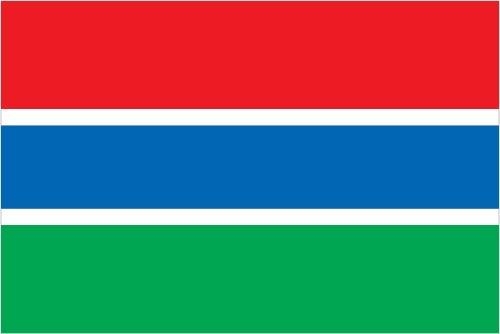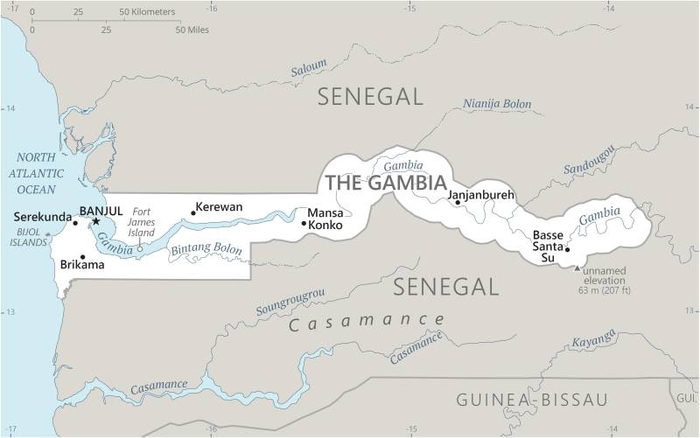198 Gambia

Three equal horizontal bands of red (top), blue with white edges, and green. Red stands for the sun and the savannah, blue represents the Gambia River, and green symbolizes forests and agriculture. The white stripes denote unity and peace.
Flag courtesy of the CIA World Factbook

Map courtesy of the CIA World Factbook

Senegambian stone circles (megaliths) which run from Senegal through the Gambia and are described by UNESCO as “the largest concentration of stone circles seen anywhere in the world”.
Government
According to Britannica, the Gambia is a multiparty republic. Under the constitution that was ratified 1996 and went into effect in 1997, the president, who is the head of state and government, is elected by universal suffrage to a five-year term. The president appoints the vice president and cabinet members. Legislative power is held by the National Assembly, comprising 53 members who serve five-year terms. The majority of members are elected, while five are appointed by the president.
The Gambia is organized into Local Government Areas (LGA), each of which either is coterminous with a long-standing administrative unit known as a division or corresponds with roughly half of a division. The city of Banjul and the Kanifing Municipality each form a separate LGA. Most decision making is done at the village level by traditional leaders and councils of elders. Only serious or contentious matters are referred to district or government bodies.
An independent judiciary is guaranteed under the constitution. The highest judicial body is the Supreme Court. Other venues include the Court of Appeal, the High Court, and the Special Criminal Court, and there are Magistrate Courts and tribunals at lower levels. The Gambia’s judicial system also provides for the implementation of Sharīʿah (Islamic law) in the venue known as the Cadi Court; this court can be used by the Muslim community to resolve such issues as marriage, divorce, and matters affecting dependents.
Gambia Civil Aviation Authority (GCAA)
The Gambia Civil Aviation Authority (GCAA) was established as an autonomous body in July, 1991 (under the Public Enterprise Act of 1989) to give effect to the Chicago Convention. The main functions of the Authority are:
- Regulating Civil Aviation and the Air Transport Industry in the Gambia,
- Providing Air Navigation Services and
- Operating and Managing Banjul International Airport which includes, among others, providing and maintaining required infrastructure and facilities.
The Authority comprises 8 different directorates namely:
- Departments of Human Resources and Administration;
- Air Navigation Services;
- Internal Audit;
- Flight Safety Standards;
- Airport Operations;
- Air Transport and Commerce;
- Finance, and
- Engineering & Maintenance
The GCAA is tasked with the collective responsibility of regulating the air transport industry in the Gambia, providing air navigation services as well as operating Banjul International Airport. Each of these directorates, headed by a Director who assists the Office of Director General in the day-to-day administration of the Authority, performs specialized functions geared towards efficiently and effectively performing the Authority’s three broad functions.
Airspace
SkyVector – Google Maps – ADS-B Exchange
ICAO countries publish an Aeronautical Information Publication (AIP). This document is divided into three parts: General (GEN), En Route (ENR) and Aerodromes (AD). ENR 1.4 details the types of airspace classes they chose to adopt from classes A through G.
Drone Regulations
Advanced Air Mobility (AAM) Regulations & Policies
None found by the author.
However, should you, the reader, happen to stumble across something to the contrary, please email the author at FISHE5CA@erau.edu and you may be mentioned in the ACKNOWLEDGEMENTS section of this book by way of thanks for contributing to this free eBook!
Advanced Air Mobility (AAM) News
None found by the author.
However, should you, the reader, happen to stumble across something to the contrary, please email the author at FISHE5CA@erau.edu and you may be mentioned in the ACKNOWLEDGEMENTS section of this book by way of thanks for contributing to this free eBook!
Short Essay Questions
Scenario-Based Question
You have been hired by a Drone Startup Company. Your boss has immediately assigned this job to you.
They need you to prepare a one-page memo detailing the legalities of using a drone to film the megaliths, pictured above.
They need you to mention any national laws and local ordinances.
They specifically want to know what airspace (insert pictures) you will be operating in and whether or not you need an airspace authorization.
Does it matter whether or not you are a citizen of the country?
Lastly, there is a bonus for you if, as you scroll through this chapter, you find any typos or broken links!
Short Essay Questions
- What are the drone categories?
- How is registration addressed?
- How is remote ID addressed?
- What are the model aircraft rules?
- What are the commercial drone rules?
- Are there waivers or exemptions to the rules? If so, for what?
- Would you share a link to an interactive airspace map?
- How is BVLOS addressed?
- How can you fly drones at night?
- How can you fly drones over people?
- Where do you find drone NOTAMs?
- What are the rules for drone maintenance?
- What are the rules for an SMS program?
- What are some unique rules not mentioned above?
- What are the C-UAS rules?
- What are the AAM rules?

